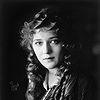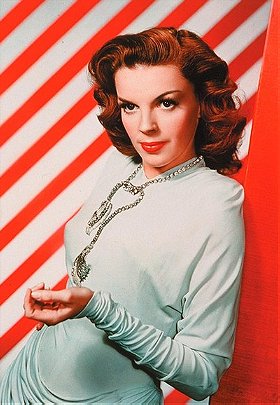Judy Garland
Stats
Birth Name: Frances Ethel Gumm
Born: 10 June 1922 Died: 22 June 1969
Country of origin:  United States
United States
Lists
418 votes
The evolution of...
(739 items)list by johanlefourbe
Published 13 years, 5 months ago  66 comments
66 comments
 66 comments
66 comments209 votes
Celebrity Dolls by Noel Cruz
(56 items)list by 리나
Published 13 years, 7 months ago  39 comments
39 comments
 39 comments
39 comments201 votes
Premature Deaths (Actors and Actresses)
(133 items)list by xolmis
Published 9 years, 2 months ago  30 comments
30 comments
 30 comments
30 comments169 votes
Celebrities Who Attempted Suicide
(18 items)list by Coby
Published 13 years ago  15 comments
15 comments
 15 comments
15 comments160 votes
Impossible celebrity couples
(50 items)list by El Raulo
Published 13 years, 4 months ago  31 comments
31 comments
 31 comments
31 commentsView all Judy Garland lists
Judy Garland Videos
Judy Garland - Get Happy - Summer Stock - 1950 Great Performance HD
164 Views, 1 votes
Added 10 years ago
View all Judy Garland videos
Photos
View all Judy Garland pictures
Description:
Judy Garland was born Frances Ethel Gumm on 10 June 1922 in Grand Rapids, Minnesota, the youngest daughter of vaudevillians Frank and Ethel Gumm. Her mother, an ambitious woman gifted in playing various musical instruments, saw the potential in her daughter at the tender age of just 2-years-old when Baby Frances repeatedly sang "Jingle Bells" until she was dragged from the stage kicking and screaming during one of their Christmas shows and immediately drafted her into a dance act, entitled "The Gumm Sisters", along with her older sisters Mary Jane Gumm and Virginia Gumm. However, knowing that her youngest dau
... (more)
Tags:
My tags:
Movies
Most popular
Top rated
Most recent

1. The Wizard of Oz (1939)
| Rating: | 3441 Watched |

2. P.S. I Love You (2007)
| Rating: | 1803 Watched |

5. Judgment at Nuremberg (1961)
| Rating: | 290 Watched |
View all Judy Garland movies (59 more)
TV
Most popular
Top rated
Most recent

1. Today (1952)
| Rating: | 94 Watched |

2. The Tonight Show Starring Johnny Carson (1962)
| Rating: | 89 Watched |
View all Judy Garland TV (37 more)
Music
Most popular
Most recent

1. The Wizard of Oz (1995)
| Rating: | 8 own |

4. Meet Me in St. Louis (1995)
| Rating: | 3 own |
View all Judy Garland music (26 more)
Update feed
Sparky The Barbarian voted for an image 3 days, 12 hours ago
heydrichenjoy added this to a list 2 weeks, 4 days ago
Oiga usted, ¡qué bien se ve! (758 person items)
Agent Kermit D. Fonz added this to a list 3 months, 4 weeks ago
Gone, but not forgotten (1852 person items)
Sparky The Barbarian voted for an image 4 months, 2 weeks ago
Agent Kermit D. Fonz added this to a list 7 months, 4 weeks ago
Iconic People and Celebrities (1031 person items)
Music2023 voted for an image 9 months ago
lookleft2 voted for an image 10 months, 3 weeks ago
moviebuff voted for an image 11 months ago
Sparky The Barbarian voted for an image 11 months, 1 week ago
Agent Kermit D. Fonz voted for an image 11 months, 2 weeks ago
Sparky The Barbarian voted for an image 1 year, 2 months ago
mrcinema1973 posted a image 1 year, 3 months ago
Kyle Ellis added this to a list 1 year, 3 months ago
Favorite Person (107 person items)
ressan voted for an image 1 year, 5 months ago
Kyle Ellis added this to a list 1 year, 8 months ago
Quattroporte voted for an image 1 year, 10 months ago
Sparky The Barbarian voted for an image 1 year, 10 months ago
apo55a voted for an image 1 year, 10 months ago
SA-512 posted a image 1 year, 12 months ago
Campagnola posted a image 2 years, 1 month ago
Campagnola posted a image 2 years, 2 months ago
Campagnola posted a image 2 years, 3 months ago
Onion Jack added this to a list 2 years, 3 months ago
 Greatest Female Singers (100 person items)
Greatest Female Singers (100 person items)"► ► ► 82 ◄ ◄ ◄POINTSJUDY GARLAND (Dear Mr. Gable) You Made Me Love You (1937) Over the Rainbow (1939) For Me and My Gal (1942) The Trolley Song (1944) The Man that Got Away (1954)"
SA-512 posted a image 2 years, 4 months ago
Onion Jack added this to a list 2 years, 5 months ago
 Now This Is What We Call Beauty in Music - Vol. 1 (100 person items)
Now This Is What We Call Beauty in Music - Vol. 1 (100 person items)" FRANCES ETHEL GUMMBorn: 10 June 1922Died: 22 June 1969Grammies: 2 0Top 10s: 6 (0) 0 (0) Over the Rainbow (1939) - 5I'm Nobody's Baby (1940) - 3For Me and My Gal (1942) - 3The Trolley Song (1944) - 4Yah-Ta-Ta, Yah-Ta-Ta (Talk, Talk, Talk) (1945) - 5On the Atchison, Topeka and the Santa Fe (1945) - 9"
Dagobert added this to a list 2 years, 5 months ago
Onion Jack added this to a list 2 years, 5 months ago
 Beauty in Film - A World Long Before Instagram (100 person items)
Beauty in Film - A World Long Before Instagram (100 person items)" FRANCES ETHEL GUMMBorn: 10 June 1922Movies: 1929-1963Died: 22 June 1969"
Onion Jack voted for 3 images 2 years, 6 months ago
SA-512 posted a image 2 years, 8 months ago
 Login
Login























































































 Best Listal's Lists
Best Listal's Lists
















 Young Celebrity Deaths
Young Celebrity Deaths


